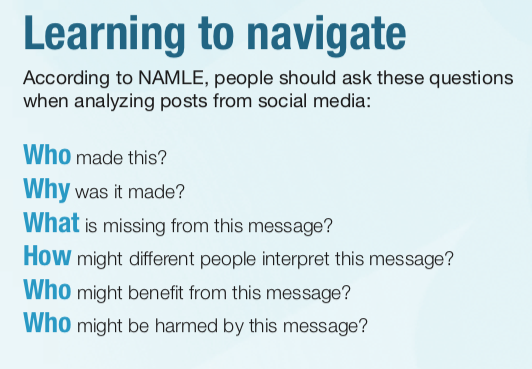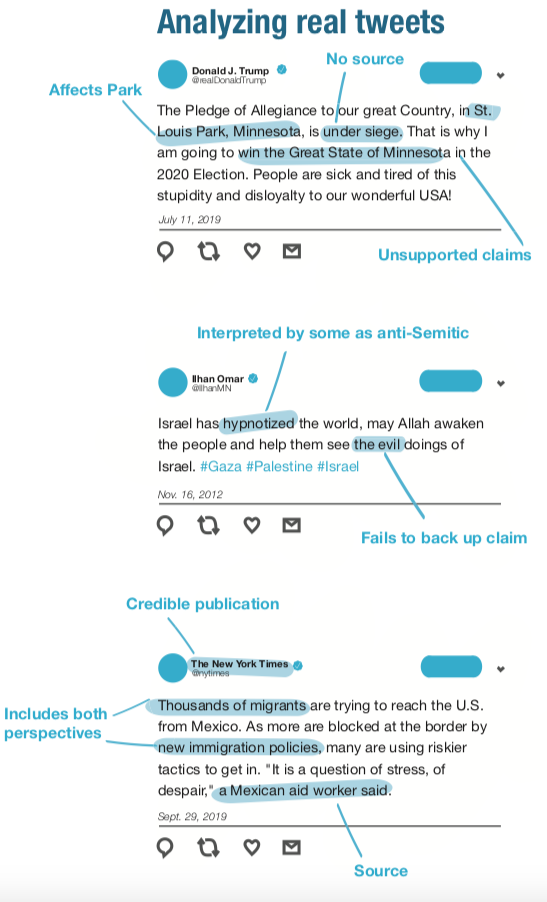According to Associate Director for the National Association for Media Literacy Education (NAMLE) Donnel Probst, social media is more convenient than a news site because of convenience.
Social media posts camouflaged as news
Online sources allow for rampant spread of misinformation
October 8, 2019
Evolution of news
Communications and journalism professor at the University of Minnesota Chris Ison said the modernized media has replaced reliable news from trained journalists with posts from online bloggers.
“Journalists used to be the gatekeepers. Those were the folks who decided what the news was. Today, while (different journalists) might have slightly different interpretations of the news, generally everyone was hearing and seeing the same (things),” Ison said. “Today everyone can publish their revision of what they call ‘news.’”
Many students re-post politicians to show what they believe in said junior Elie Grassley.
“A lot of people, especially in the younger generation, think it is really important that everyone knows what’s going on because it’s a part of our everyday life,” Grassley said.
High school librarian Ellen George said social media has allowed for the spread of false news and recommends students look elsewhere for information.
“We have had a lot of bad experiences in this country with social media and the ability to pass on false news without anyone making sure that something is correct before it gets spread,” George said.
According to Ison, politicians skip the fact checking of mainstream media by using social media for communication.
“Anybody can get news out there and it can get picked up and swept around really quickly,” Ison said. “Politicians among them are able to bypass legitimate news organizations to get their message out.”
Convenience attracts
Grassley said politics have become increasingly inclusive through the direct communication of officials and supporters on social media, however, many fail to check the reliability of sources.
“I think this election, politicians using social media is a really big thing, everyone running for president has an Instagram and is using it as a platform to reach young people,” Grassley said. “I think it is very important for politicians to use social media.”
Associate Director for the National Association for Media Literacy Education (NAMLE) Donnel Probst said social media is more appealing than a news site because it is more straightforward making it more convenient.
“Because teenagers use social media so much, they tend to start to use that as a crutch in place of new sources,” Probst said. “As they get older and start to get involved in civic engagement, rather than reading a news story or a longer story, they will rely on their feed in order to inform 
themselves about what is happening in the world with politics and what’s relevant.”
Students fail to do their own research, leading them to repost and believe in fake news, which in turn can confuse their followers, according to Grassley.
“There are some things that people put on their stories where they didn’t look thoroughly enough or research it enough where it may not be true,” Grassley said. “I think (in) those cases people can be misinformed and people need to check that what they are putting out there is true and not fake.”
Freshman Manny Shetaye said it is more effective for students to post their own opinions rather than blindly following potentially misleading sources.
“People see (a post) and they agree with it a lot and decide to share it. It’s annoying that they never write anything on their own,” Shetaye said. “Some Instagram accounts can post (false information) and then if you repost it people might not know where it is from.”
According to sophomore Abby Turcott, students are reposting stories in order to impress others in the mix of becoming popular.
“I think people post for likes and popularity because if the person they are reposting is popular and agrees with
something, they can get popular for liking the same thing,” Turcott said.
Reposting intentionally
Ison said it is the responsibility of the audience to check the reliability of what they are reading.
“What we are all talking about these days is the need for more media literacy in the public. It’s hard work being well informed these days,” Ison said. “The audience needs to work harder.”
According to Probst, the reader has to evaluate every part of the information before believing it.
“Students need to be very mindful about how they are using social media so that they can ensure that when they are posting things they are not stretching reality,” Probst said. “Really understand how to look at your sources. Critically analyzing every piece of information you come across.”
According to George, there are many fact-checking sources available to high school students on the school website.
“We have the online Britannica through the state library access. I have a lot of reference books.” George said. “We have on the high school website the database Symbaloo.”
What really matters when getting your news is who is producing the story not the medium from which you get it, according to Ison.
“Social media is just a vehicle for information. It doesn’t really matter whether you’re getting it from social media or regular media, the question is who is originating the information,” Ison said.
Grassley said when she reposts something to her Instagram story, she double-checks to make sure everything is current and accurate.
“Whenever I put something on my story, I usually look it up first and make sure it’s true and it’s not fake. Usually, it’s about something that’s happening currently,” Grassley said. “I think it’s important to check your resources.”
There are many reliable sources, but it is essential that students are aware of any possible bias, according to George.
“Are there any red flags? Did it come from a reputable journalistic source like The New York Times, The Washington Post?” George said. “We’ve got lots of resources here for you. Ask your teacher, ask the librarian.”

